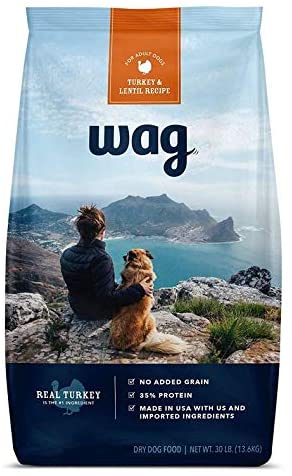
DogFoodAdvisor is reader supported See how
All reviews are 100% impartial but if you buy using links on this page, we may earn a referral fee.
Our Verdict
Wag Dog Food dry product range is made up of 11 recipes with ratings varying from 4 to 4.5 stars. The average rating of the whole range is 4.5 stars.
The table below shows each recipe in this range including our rating and the AAFCO nutrient profile: Growth (puppy), Maintenance (adult), All Life Stages, Supplemental or Unspecified.
| Product line | Rating | AAFCO |
|---|---|---|
| Wag Wholesome Grains Salmon and Brown Rice | 4 | A |
| Wag Wholesome Grains Chicken and Brown Rice | 4 | A |
| Wag Wholesome Grains Beef and Brown Rice | 4 | A |
| Wag Beef and Sweet Potato | 4.5 | A |
| Wag Chicken and Sweet Potato Grain Free | 4.5 | A |
| Wag Salmon and Sweet Potato Grain Free | 4.5 | A |
| Wag Salmon and Lentil Recipe | 4.5 | A |
| Wag Beef and Lentil Recipe with Wild Boar | 4.5 | A |
| Wag Turkey and Lentil Recipe | 4.5 | A |
| Wag Lamb and Lentil Recipe | 4.5 | A |
| Wag Chicken and Lentil for Puppies | 4.5 | A |
Recipe and Label Analysis
Wag Turkey and Lentil Recipe was selected to represent the other products in the line for detailed recipe and nutrient analysis.
Wag Turkey and Lentil Recipe
Estimated Dry Matter Nutrient Content
Protein
Fat
CarbsCarbohydrates
Turkey, turkey meal, lentils, pea protein, peas, chicken fat (preserved with mixed tocopherols), brewers yeast, dried plain beet pulp, flaxseed, natural flavor, salmon oil, calcium carbonate, salt, choline chloride, dried chicory root, Yucca schidigera extract, dried Lactobacillus plantarum fermentation product, dried Bacillus subtilis fermentation product, dried Enterociccus faecium fermentation product, dried Bifidobacterium animalis fermentation product, vitamin E supplement, iron proteinate, zinc proteinate, copper proteinate, ferrous sulfate, zinc sulfate, copper sulfate, potassium iodide, thiamine mononitrate (source of vitamin B1), manganese proteinate, manganous oxide, ascorbic acid (preservative), vitamin A supplement, biotin, niacin, calcium pantothenate, manganese sulfate, sodium selenite, pyridoxine hydrochloride (source of vitamin B6), vitamin B12 supplement, riboflavin (vitamin B2), vitamin D3 supplement, folic acid
Fiber (estimated dry matter content) = 4.5%
Red denotes any controversial items
| Estimated Nutrient Content | |||
|---|---|---|---|
| Method | Protein | Fat | Carbs |
| Guaranteed Analysis | 35% | 15% | NA |
| Dry Matter Basis | 39% | 17% | 36% |
| Calorie Weighted Basis | 34% | 35% | 31% |
Ingredients Analysis
The first ingredient in this dog food is turkey. Although it is a quality item, raw turkey contains up to 73% water. After cooking, most of that moisture is lost, reducing the meat content to just a fraction of its original weight.
After processing, this item would probably account for a smaller part of the total content of the finished product.
The second ingredient is turkey meal. Turkey meal is considered a meat concentrate and contains nearly 300% more protein than fresh turkey.
The third ingredient includes lentils. Lentils are a quality source of carbohydrates. Plus (like all legumes) they’re rich in natural fiber.
However, lentils contain about 25% protein, a factor that must be considered when judging the actual meat content of this dog food.
The fourth ingredient is pea protein, what remains of a pea after removing the starchy part of the vegetable.
Even though it contains over 80% protein, this ingredient would be expected to have a lower biological value than meat.
And less costly plant-based products like this can notably boost the total protein reported on the label — a factor that must be considered when judging the meat content of this dog food.
The fifth ingredient lists peas. Peas are a quality source of carbohydrates. And like all legumes, they’re rich in natural fiber.
However, peas contain about 25% protein, a factor that must be considered when judging the meat content of this dog food.
The sixth ingredient is chicken fat. This item is obtained from rendering chicken, a process similar to making soup in which the fat itself is skimmed from the surface of the liquid.
Chicken fat is high in linoleic acid, an omega-6 fatty acid essential for life. Although it doesn’t sound very appetizing, chicken fat is actually a quality ingredient.
The next ingredient is brewers yeast, which can be a controversial item. Although it’s a by-product of the beer making process, this ingredient is rich in minerals and other healthy nutrients.
Fans believe yeast repels fleas and supports the immune system.
Critics argue yeast ingredients can be linked to allergies. This may be true, but (like all allergies) only if your particular dog is allergic to the yeast itself.
In addition, a vocal minority insists yeast can increase the risk of developing the life-threatening condition known as bloat. However, this is a claim we’ve not been able to scientifically verify.
In any case, unless your dog is specifically allergic to it, yeast can still be considered a nutritious additive.
What’s more noteworthy here is that brewers yeast contains about 48% protein, a factor that must be considered when judging the actual meat content of this dog food.
The eighth ingredient is beet pulp. Beet pulp is a controversial ingredient, a high fiber by-product of sugar beet processing.
Some denounce beet pulp as an inexpensive filler while others cite its outstanding intestinal health and blood sugar benefits.
We only call your attention here to the controversy and believe the inclusion of beet pulp in reasonable amounts in most dog foods is entirely acceptable.
The ninth ingredient is flaxseed, one of the best plant sources of healthy omega-3 fatty acids. Provided they’ve first been ground into a meal, flax seeds are also rich in soluble fiber.
However, flaxseed contains about 19% protein, a factor that must be considered when judging the actual meat content of this dog food.
From here, the list goes on to include a number of other items.
But to be realistic, ingredients located this far down the list (other than nutritional supplements) are not likely to affect the overall rating of this Wag product.
With four notable exceptions…
First, we find salmon oil. Salmon oil is naturally rich in the prized EPA and DHA type of omega-3 fatty acids. These two high quality fats boast the highest bio-availability to dogs and humans.
Depending on its level of freshness and purity, salmon oil should be considered a commendable addition.
Next, chicory root is rich in inulin, a starch-like compound made up of repeating units of carbohydrates and found in certain roots and tubers.
Not only is inulin a natural source of soluble dietary fiber, it’s also a prebiotic used to promote the growth of healthy bacteria in a dog’s digestive tract.
In addition, this recipe contains sodium selenite, a controversial form of the mineral selenium. Sodium selenite appears to be nutritionally inferior to the more natural source of selenium found in selenium yeast.
And lastly, this food includes chelated minerals, minerals that have been chemically attached to protein. This makes them easier to absorb. Chelated minerals are usually found in better dog foods.
Nutrient Analysis
Based on its ingredients alone, Wag Dog Food looks like an above-average dry product.
The dashboard displays a dry matter protein reading of 39%, a fat level of 17% and estimated carbohydrates of about 36%.
As a group, the brand features an average protein content of 29.7% and a mean fat level of 16.7%. Together, these figures suggest a carbohydrate content of 46.4% for the overall product line.
And a fat-to-protein ratio of about 54%.
Which means this product contains…
Near-average protein. Near-average fat. And below-average carbs when compared to other kibbles.
However, when you consider the protein-boosting effect of the lentils, pea protein, peas, brewers yeast and flaxseed, this looks like the profile of a dry product containing just a notable amount of meat.
Wag Dog Food Recall History
The following automated list (if present) includes all dog food recalls related to Wag through December 2025.
No recalls noted.
You can view a complete list of all dog food recalls since 2009 here.
Our Rating of Wag Grain Free and Grain Inclusive Dog Food
Wag includes both grain-free and grain-inclusive dry dog foods that utilize a notable amount of named meat meals as its dominant source of animal protein, thus earning the brand 4.5 stars.
Compare Wag Dog Food
How does Wag compare with The Dog Food Advisor's most recommended brands?
A Final Word
The Dog Food Advisor does not accept money, gifts, samples or other incentives in exchange for special consideration in preparing our reviews.
However, we do receive a referral fee from online retailers (like Chewy or Amazon) and from sellers of perishable pet food when readers click over to their websites from ours. This helps cover the cost of operation of our free blog. Thanks for your support.
For more information, please visit our Disclaimer and Disclosure page.








